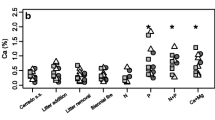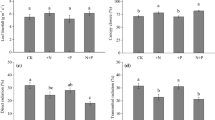Abstract
The relationships among leaf traits often reflect plant adaptation for coping with nutrient resources. However, the seasonal variations in leaf traits and their relationship with soil nutrients are not well understood. We sampled seven major functional traits of thirty trees and nine shrubs (sorted into different plant functional groups, PFGs, based on their growth form, leaf lifespan, and leaf shape) at different seasons in a managed forest plantation of Southeastern China. Both green leaf nitrogen and phosphorus concentrations (Ngreen and Pgreen) decreased significantly from spring and summer to autumn, and varied significantly with PFGs (P < 0.05) at different times of the year. Across all plants, specific leaf area correlated positively with Ngreen and Pgreen in spring, summer, and winter, but not in autumn; N resorption proficiency generally correlated positively with Ngreen in each season, while P resorption efficiency correlated positively with Pgreen in spring and summer, but not in autumn and winter. Soil nitrogen availability correlated negatively with leaf nutrient traits in some seasons. In conclusion, leaf trait relationships varied among the seasons and among PFGs. Seasonal dynamics of leaf traits as well as soil nutrients’ relations must be considered when exploring plant feedback to soil nutrients.

Similar content being viewed by others
References
Ackerly DD et al (2000) The evolution of plant ecophysiological traits: recent advances and future directions. Bioscience 50:979–995
Aerts R (1996) Nutrient resorption from senescing leaves of perennials: are there general patterns? J Ecol 84:597–608
Aerts R, Chapin FS (2000) The mineral nutrition of wild plants revisited: a re-evaluation of processes and patterns. Adv Ecol Res 30:1–67
Allen SE (1989) Chemical analysis of ecological materials. Blackwell, Oxford
Chabot BF, Hicks DJ (1982) The ecology of leaf life spans. Annu Rev Ecol Syst 13:229–259
Chapin FS (1980) The mineral nutrition of wild plants. Annu Rev Ecol Syst 11:233–260
Chapin FS, Kedrowski RA (1983) Seasonal-changes in nitrogen and phosphorus fractions and autumn retranslocation in evergreen and deciduous taiga trees. Ecology 64:376–391
Chen FS, Fahey TJ, Yu MY, Gan L (2010a) Key nitrogen cycling processes in pine plantations along a short urban–rural gradient in Nanchang, china. For Ecol Manag 259:477–486
Chen FS, Zeng DH, Fahey TJ, Yao CY, Yu ZY (2010b) Response of leaf anatomy of Chenopodium acuminatum to soil resource availability in a semi-arid grassland. Plant Ecol 209:375–382
Chen FS, Niklas KJ, Zeng DH (2011) Important foliar traits depend on species-grouping: analysis of a remnant temperate forest at the Keerqin sandy lands, China. Plant Soil 340:337–345
Cornelissen JHC et al (2003) A handbook of protocols for standardised and easy measurement of plant functional traits worldwide. Aust J Bot 51:335–380
Cunningham SA, Summerhayes B, Westoby M (1999) Evolutionary divergences in leaf structure and chemistry, comparing rainfall and soil nutrient gradients. Ecol Monogr 69:569–588
Falster DS, Warton DI, Wright IJ (2006) User’s guide to SMATR: standardised major axis tests & routines. Version 2.0. http://bio.mq.edu.au/ecology/SMATR/SMATR_users_guide.pdf
Falster DS, Reich PB, Ellsworth DS, Wright IJ, Westoby M, Oleksyn J, Lee TD (2012) Lifetime return on investment increases with leaf lifespan among 10 Australian woodland species. New Phytol 193:409–419
Grime JP et al (1997) Integrated screening validates primary axes of specialisation in plants. Oikos 79:259–281
He JS, Wang ZH, Wang XP, Schmid B, Zuo WY, Zhou M, Zheng CY, Wang MF, Fang JY (2006) A test of the generality of leaf trait relationships on the Tibetan plateau. New Phytol 170:835–848
Jackson RB, Mooney HA, Schulze E-D (1997) A global budget for fine root biomass, surface area, and nutrient contents. Proc Natl Acad Sci USA 94:7362–7366
Killingbeck KT (1996) Nutrients in senesced leaves: keys to the search for potential resorption and resorption proficiency. Ecology 77:1716–1727
Kobe RK, Lepczyk CA, Iyer M (2005) Resorption efficiency decreases with increasing green leaf nutrients in a global data set. Ecology 86:2780–2792
Lavorel S, McIntyre S, Landsberg J, Forbes TDA (1997) Plant functional classifications: from general groups to specific groups based on response to disturbance. Trends Ecol Evol 12:474–478
Luxmoore RJ (1991) A source sink framework for coupling water, carbon, and nutrient dynamics of vegetation. Tree Physiol 9:267–280
Mueller KE, Hobbie SE, Oleksyn J, Reich PB, Eissenstat DM (2012) Do evergreen and deciduous trees have different effects on net N mineralization in soil? Ecology 93(6):1463–1472
Niinemets U (2001) Global-scale climatic controls of leaf dry mass per area, density, and thickness in trees and shrubs. Ecology 82:453–469
Niinemets U, Kull K (2003) Leaf structure vs. nutrient relationships vary with soil conditions in temperate shrubs and trees. Acta Oecol 24:209–219
Niklas KJ (1999) A mechanical perspective on foliage leaf form and function. New Phytol 143:19–31
Ordoñez JC, van Bodegom PM, Witte JPM, Wright IJ, Reich PB, Aerts R (2009) A global study of relationships between leaf traits, climate and soil measures of nutrient fertility. Global Ecol Biogeogr 18:137–149
Poorter H, Bergkotte M (1992) Chemical-composition of 24 wild-species differing in relative growth-rate. Plant Cell Environ 15:221–229
Poorter H, Nagel O (2000) The role of biomass allocation in the growth response of plants to different levels of light, CO2, nutrients and water: a quantitative review. Aust J Plant Physiol 27:595–607
Reich PB, Oleksyn J (2004) Global patterns of plant leaf N and P in relation to temperature and latitude. Proc Natl Acad Sci USA 101:11001–11006
Reich PB, Walters MB, Ellsworth DS (1992) Leaf life-span in relation to leaf, plant, and stand characteristics among diverse ecosystems. Ecol Monogr 62:365–392
Reich PB, Walters MB, Ellsworth DS (1997) From tropics to tundra: global convergence in plant functioning. Proc Natl Acad Sci USA 94:13730–13734
Reich PB, Walters MB, Ellsworth DS, Vose JM, Volin JC, Gresham C, Bowman WD (1998) Relationships of leaf dark respiration to leaf nitrogen, specific leaf area and leaf life-span: a test across biomes and functional groups. Oecologia 114:471–482
Sands R, Mulligan DR (1990) Water and nutrient dynamics and tree growth. For Ecol Manag 30:91–111
Santiago LS, Wright SJ (2007) Leaf functional traits of tropical forest plants in relation to growth form. Funct Ecol 21:19–27
Schulze ED, Kelliher FM, Korner C, Lloyd J, Leuning R (1994) Relationships among maximum stomatal conductance, ecosystem surface conductance, carbon assimilation rate, and plant nitrogen nutrition—a global ecology scaling exercise. Annu Rev Ecol Syst 25:629–660
Sobrado MA, Medina E (1980) General morphology, anatomical structure, and nutrient content of sclerophyllous leaves of the ‘Bana’ vegetation of Amazonas. Oecologia 45:341–345
SPSS Inc. (2001) SPSS for Windows (10.0). SPSS Inc., Chicago
Warton DI, Wright IJ, Falster DS, Westoby M (2006) Bivariate line-fitting methods for allometry. Biol Rev 81:259–291
Westoby M, Falster DS, Moles AT, Vesk PA, Wright IJ (2002) Plant ecological strategies: some leading dimensions of variation between species. Annu Rev Ecol Syst 33:125–159
Wright IJ, Westoby M (2003) Nutrient concentration, resorption and lifespan: leaf traits of Australian sclerophyll species. Funct Ecol 17:10–19
Wright IJ, Reich PB, Westoby M (2001) Strategy shifts in leaf physiology, structure and nutrient content between species of high- and low-rainfall and high- and low-nutrient habitats. Funct Ecol 15:423–434
Wright IJ et al (2004a) Leaf trait relationships in Australian plant species. Funct Plant Biol 31:551–558
Wright IJ et al (2004b) The worldwide leaf economics spectrum. Nature 428:821–827
Wright IJ et al (2005a) Assessing the generality of global leaf trait relationships. New Phytol 166:485–496
Wright IJ et al (2005b) Modulation of leaf economic traits and trait relationships by climate. Global Ecol Biogeogr 14:411–421
Yu K (2010) Leaf structure and nutrient traits across important garden plants under hilly red soil in mid-subtropical region: the case of the new campus of Nanchang University. Master thesis, Nanchang University (in Chinese)
Acknowledgments
This study was supported by Grants from the National Basic Research Program of China (973 Program, 2012CB416903) and the National Natural Science Foundation of China (30960311 and 31160107). We greatly appreciate Xiao-Fei Hu, Kun Yu, Xue Feng, and Wen Ren for their help in sampling and soil analyses and Dr. De-Hui Zeng for manuscript improvement. Several anonymous reviewers and the editor Dr. Rebecca Ostertag have significantly improved the quality of this paper.
Author information
Authors and Affiliations
Corresponding author
Electronic supplementary material
Below is the link to the electronic supplementary material.
Table S1
Leaf traits of 13 species selected in this study in the forest plantation (PDF 38 kb)
Rights and permissions
About this article
Cite this article
Chen, FS., Niklas, K.J., Chen, GS. et al. Leaf traits and relationships differ with season as well as among species groupings in a managed Southeastern China forest landscape. Plant Ecol 213, 1489–1502 (2012). https://doi.org/10.1007/s11258-012-0106-5
Received:
Accepted:
Published:
Issue Date:
DOI: https://doi.org/10.1007/s11258-012-0106-5




